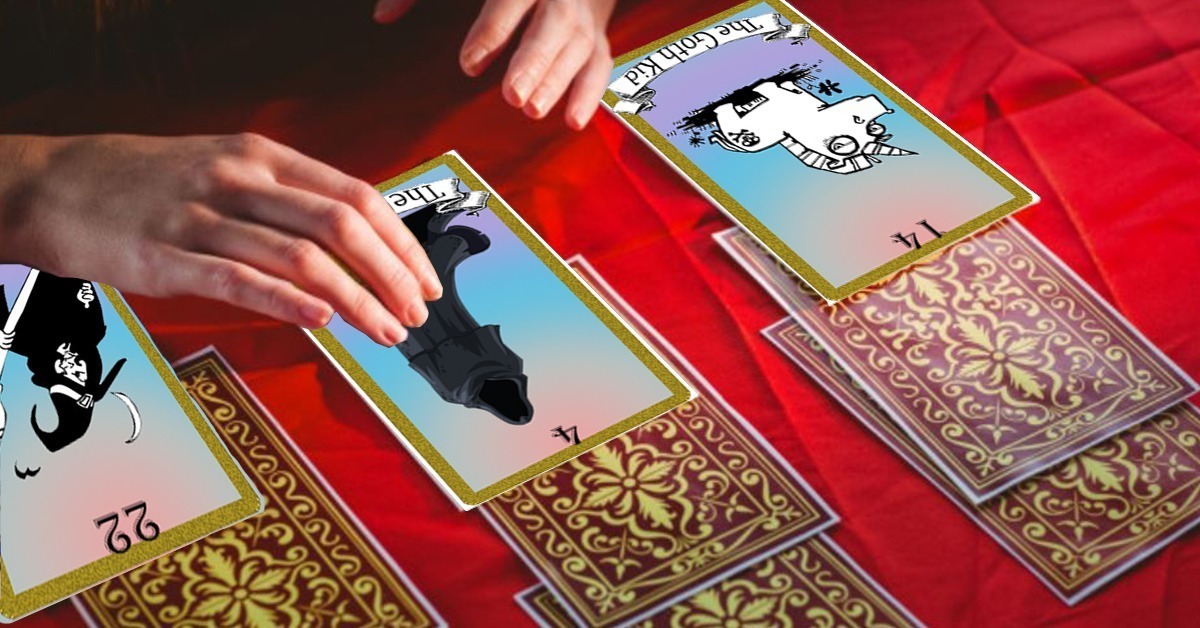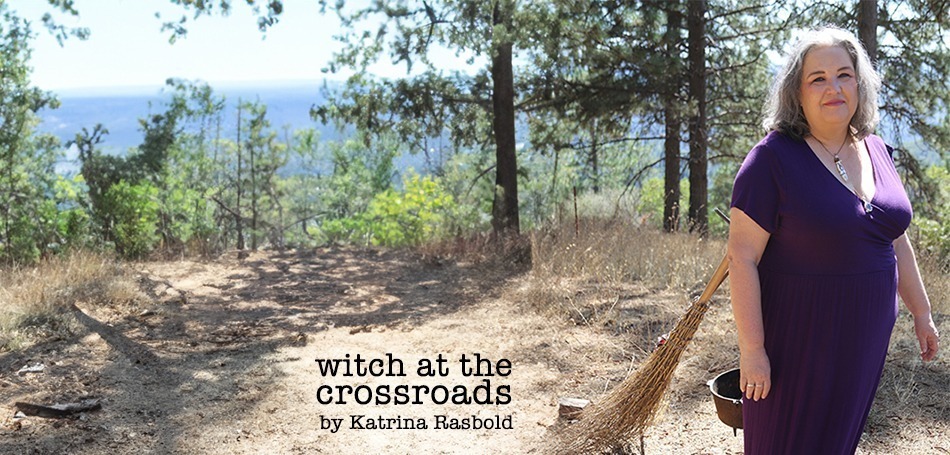
Archetypes, labels, and cubbyholes. Did we invent them or did they invent us?
There comes a time when you are an old crone sitting back and watching the world turn when you begin to feel like there is nothing new under the sun. When something does spark interest as a new thought, new idea, new concept, new approach, it is exciting, breath-taking even. Mostly because it is so rare. I never imagined that I would be as jaded as I am, thankful for all of the wonders in the world, but bored with them all the same. And yet, here I am, jaded as the evergreens that grow around me and almost as old.
Pagan Archetypes
I have spent over thirty years running circles/covens and twenty years of being involved on various levels with running and participating in major Pagan festival and events. Throughout those years, I have had multiple opportunities to observe and study the group dynamics involved. From that, comes this tongue-in-cheek exploration of some of the primary archetypes of Pagan groups. In any given group, there might be more than one of these types, but there will very often be at least one. I make these observation with love and in some ways, resignation for what Pagan leaders must manage on a regular basis.
Archetypes Regenerate!
Throughout the years, I have seen these archetypes manifest with profound predictability. When the embodiment of one archetype leaves the group, like Pez, a replacement appears. We all know who they are, whether anyone ever actively addresses it or not. Some we love because of their archetypical behavior and some we love in spite of it. As my sweet Granny used to say, “Some people are just harder to love.”
All Negativity Aside…
The identification and description of these archetypes is not intended as condemnation, but merely as an objective observation that “this is a thing that happens.” This started off as a discussion of four or five archetypes and soon, it bloomed into an entire Tarot Card Major Arcana of them, so I figured we should have some fun with it. The assignments of numbers in this Major Arcana selection is incidental and not related to the traditional numerological or Smith-Rider-Waite progression.
As with the Smith-Rider-Waite cards, each of these archetypes is influenced by the cards around it. The blending of two or more archetypes into a group dynamic can be a recipe for delicious success or bitter failure.
(Pssst: I actually wrote a book on the Tarot and I also have a six-class course on the Tarot that goes along with the book, although you can use either independently of the other one. Book is here.
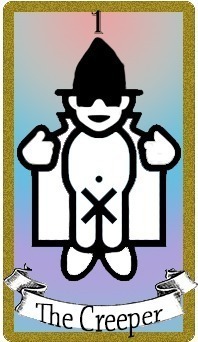 1 – The Creeper
1 – The Creeper
The creeper can be of any gender or sexual orientation, however to be ageist, I have found that they usually in the Baby Boomer generation. They come from a time when Paganism intermingled with the hippie, free love movement and are locked into the notion that all people they encounter are receptive to and excited for their sexual advances. They rarely honor boundaries or stated affinities. They hug juussssst a little too long and sometimes make guttural moaning sounds as they hug. They make unwanted sexual remarks and insist that anyone who objects is sexually repressed and is, in turn, attempting to sexually repress them.
The creeper is always the one who has a leer on their face when anyone mentions working skyclad. They frequently show signs of arousal during ritual (and are quite proud of it). Any mention of consent is quickly rebuffed or even ridiculed.
To be clear, sex and sexuality are not creepy. Sex and sexuality in ritual are not creepy. These people are creepy. I do not like having to tell the younger people in my group, “Don’t go around this vendor booth without an escort” because I know if they do, The Creeper will force them into unwanted sexual situations. No means “no,” even for Pagans.
 2 – The Martyr
2 – The Martyr
At any event, no matter how large or small, The Martyr does most of the work. How do we know this? Just wait for it…they will tell you. We love and appreciate The Martyr because without them, trust me, we would never have any Pagan events. The Martyr picks up all of the balls others drop and does their own work as well. Their own work is significant because they agree to do jobs other people reject and take on a work load that often edges beyond their resentment boundary. The Martyr arrives early and stays late.
Unfortunately, The Martyr can burn out quickly if their behavior is unchecked. Help your Martyrs. Don’t be the sloth who lets someone else do their jobs for them.
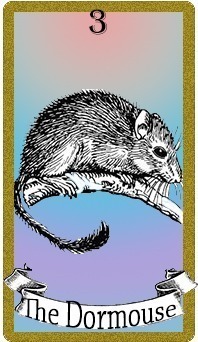 3 – The Dormouse
3 – The Dormouse
The Dormouse always has a perfectly legitimate reason for why they missed the majority of the planning meetings for any event. Ultimately, they rush in late and then have an opinion or plan for anything that comes up. They ask questions that were covered in the meeting (and put into the minutes that were uploaded to the planning group two weeks prior) and question board decisions made long ago. Why? Because they had a perfectly legitimate reason for why they missed the planning meetings.
The Dormouse “wakes up at the tea party,” says nonsensical, irrelevant, and obsolete things, then nestles back to sleep again.
My daughter pointed out that she is, in fact, the Dormouse Reversed. She shows up for the meetings, does the work, then sleeps through the event.
 4 – The Peacemaker
4 – The Peacemaker
Whenever friction arises, as it is bound to do when so many different personality types unite to try and do something, The Peacemaker steps up. This person abhors conflict and will initiate peacemaking efforts before anyone has effectively processed their feelings and then will wail “Can’t we all just get along?” while posting plaintiff Vaguebook remarks about how sad it is that the Pagan community is so broken. (Spoiler: The Pagan community is not broken because there are people in it who are not part of the Get Along Gang).
When properly aspected by the cards around it, The Peacemaker is a valuable mediation tool. When poorly aspected, it is a pain-in-the-ass person who believes enlightened people should be above human emotion and reaction when they are wronged. This form of The Peacemaker often runs out of cheeks to turn and expects everyone else to as well.
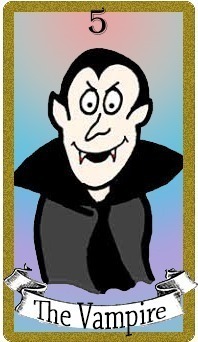 5 – The Vampire
5 – The Vampire
The Vampire sucks all of the energy out of a situation and all of the air out of the room. In a classroom environment, The Vampire makes the class all about them. In a ritual, the Vampire absorbs the energy of the circle instead of moving it through them and passing it on to the next person.
This archetype rarely contributes to the work of any event and instead shows up to avail themselves of whatever they can get from it, especially in the form of energy, attention, and free swag. They will be the one clearing the pot luck table into their own bags and taking the extra class materials and supplies for themselves.
They have little ability to look beyond their own interests and rarely notice the impact their behavior has on others. When people engage The Vampire, they come away feeling exhausted and approximately one-third to one-quarter of the way through the encounter, will pray someone passes by to rescue them, giving them a reasonable avenue of escape.
 6 – The New Ager
6 – The New Ager
I have T-shirt that says, “I am mostly love and light and a little shut the f*** up.” The New Ager is all love and light, rainbow therapy, Reiki, wheatgrass, and Namaste. They have little interest in spell work or ritual and while some identify as Pagan, their primary discussion focuses on their intensely magical (read: more magical than your stupid ordinary child) Starseed Indigo child, their last visit to the expensive upstate soul cleansing retreat, and the star gate their church is funding to transport them to the galaxy du jour. They love or despise William Rand (there is very little middle ground on this as nearly as I can tell) and do not suffer skeptics lightly.
The New Ager is an interesting archetype to be sure and their areas of expertise lend texture to our conversations. In my experience, they attend Pagan functions to feel the energy and socialize. Some delve deeply into the culture and ritual of Paganism, but not many.
 7 – The Stranger
7 – The Stranger
The Stranger shows up in a community and exhibits an unearned level of entitlement, quickly attempting to assert authority, expecting to be treated as an elder, and basically jumps the line. The challenge is that no one knows who this person is and everyone wonders how they came into prominence in the community when we were not looking. “Wait, who are you again?” and “I thought they were with YOU” “Well, I thought they were with you!” are common reactions to The Stranger. The Stranger was never at festivals emptying trash cans, selling raffle tickets, or setting up booths. They just appeared and demanded a seat at the table with those who paid their dues to the Community.
The Stranger usually has an unconfirmable, impressive-to-the-point-of-suspect lineage and speaks with great knowledge of their chosen field… until you listen more closely. Their capacity for bullshit is seemingly endless and they have a knack for identifying what a person or group needs most and ingratiating themselves into prominence by providing that very quality.
Eventually, The Stranger is exposed as a fraud, mostly because they cannot sustain the image they seek to create. They then move on to other locations to start the process again.
 8 – The Witchsplainer
8 – The Witchsplainer
Of all of the 22 archetypes, The Witchsplainer is the easiest to identify due to their predictable mating call of starting sentences with the words, “Well, actually…” The Witchsplainer knows the proper way to pronounce “athame,” rushes to correct any perceived errors, and is the keeper of “the right way” and “the wrong way.” From the proper management and distribution of cakes and ale to the order candles are lit, from the true origins of sabbat names to the details of altar arrangement, The Witchsplainer knows all.
This archetype speaks with authority about details they did not witness and facts they can never prove. Before engaging The Witchsplainer, make certain all of your academic citations are in order and never speculate. The Witchsplainer is badly aspected when faced with concepts such as “Faith” and “Intuitive Working.”
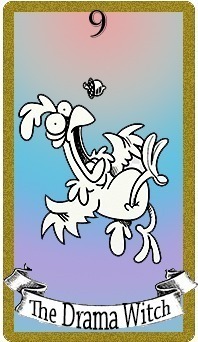 9 – The Drama Witch
9 – The Drama Witch
The Drama Witch is titled “The Shit Stirrer” in some decks, but “The Drama Witch” is the more common nomenclature. This archetype is always at the center of conflict and “the sky is falling!” tends to be their theme. They are restless and bored in times of peaceful comfort. If no drama presents, they will make one up or dig up an old one. The Drama Witch tucks away bits of information for future aces to play in the poker tournament of conversation.
Above all, this person thrives on discord and fear, living in a near constant state of aroused anxiety and a feral need for the stimulation of the battle. From a leader perspective, The Drama Witch is the most difficult to effective (or kindly) manage and my heart goes out to you if your leader IS The Drama Witch.
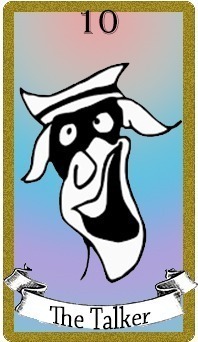 10 – The Talker
10 – The Talker
The Talker has a comment, question, correction, or addition for any conversation that ever exists in the history of human speech. If you ask people to share their experiences in ritual, The Talker will share first and longest, perhaps even multiple times. In group setting, you will find yourself leaving space for The Talker to interject because you know it is coming. The Talker has the final word, the longest anecdote, and a personal story locked and loaded for any situation.
The Talker is well aspected alongside The Witchsplainer.
 11 – The Drunk
11 – The Drunk
This archetype includes alcohol in all ritual and group gatherings. Their behavior often influences the course of events with directors creating an action plan for the inevitable management of The Drunk’s behavior. Interventions usually have no effect and accountability is slim and none with this archetype.
Like the frog boiling in the saucepan, the group often begins using explanations provided by The Drunk themselves for excusing their behavior. They are not “too plastered to lead the ritual,” they are “working on a higher level right now.” They are not “passed out in a recliner,” they are “resting up for evenings festivities because they ran too much energy in preparation for the night.”
Alcohol is a great social and spiritual addition to ritual… until it’s not.
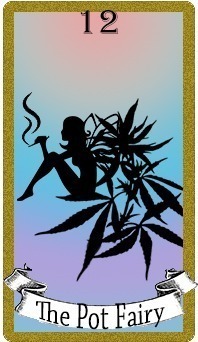 12 – The Pot Fairy
12 – The Pot Fairy
Other decks often label The Pot Fairy as “Cannibitch” and certainly, the two can easily be used interchangeably since the interpretations are identical. The Pot Fairy always knows where to get pot, likely has pot in many forms on them at any moment, and usually smells like pot. Unlike #11, The Drunk, The Pot Fairy rarely imbibes to the point of incapacitation or disruption. They may, however, partake to the point of extreme goofiness.
The Pot Fairy is also usually The Herbologist, which is a variant on the title. That is to say, many Pot Fairies are also Herbologists, but not all Herbologists are Pot Fairies. The Pot Fairy is well aspected when placed in charge of the group pot luck and any activity requiring weight or measures, especially the conversation of grams to ounces.
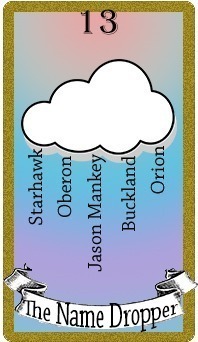 13 – The Name Dropper
13 – The Name Dropper
Like chocolate chips in a tollhouse cookie, The Name Dropper’s conversation is liberally seasoned with the mention of star encounters with Big Name Pagans. The Name Dropper knows them all, has broken bread with them all and likely drinks forties on the corner with them every Saturday night. The Name Dropper is the Fifth Beatle of the Pagan world and will gladly tell you all about it many times over.
This Major Arcana card is best aspected when alongside The Talker or The Witchsplainer.
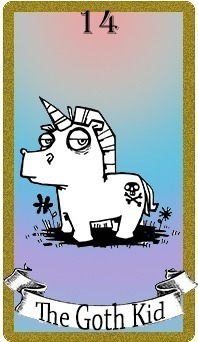 14 – The Goth Kid
14 – The Goth Kid
Despite their best efforts, The Goth Kid brings mirth and lightness to Pagan events. The Goth Kid reminds us to express our inner selves in the most obvious ways, which is a lesson some of us oldsters occasionally need as we feel the urge to isolate.
The Goth Kid is the deepest manifestation of our inner child flying high on freedom and shadow immersion. We love you, Goth Kid. Don’t ever change.
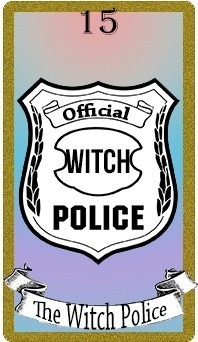 15 – The Witch Police
15 – The Witch Police
Like the 5 and 7 of Swords in a traditional deck, The Witch Police and The Witchsplainer are easy to confuse. The Witchsplainer is verbal and instructional from an ego perspective while The Witch Police is the embodiment of “to protect and to serve.” They show us the smoke detectors before those smoke detectors start screaming from sage smoke and remind #11, The Drunk, that we need an ABC license to sell booze after the ritual. The Witch Police starts their part of any gathering with, “I hate to bring this up and rain on the parade, but…”
In event planning, The Witch Police is the voice of reason, reminding the Board of Directors about things like noise restrictions and variances and health codes. They are the energetic equivalent to the kid who raises their hand to remind the teach they forgot to assign homework. They are the reason we know our insurance will not allow us to have bounce houses at festivals.
Like any governing force, this archetype is extremely important, but also a necessary wet blanket on our fort building, slip and slide managing, and axe throwing ideas.
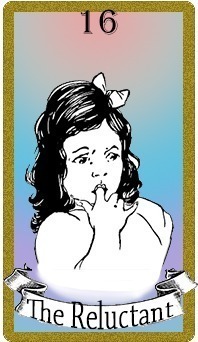 16 – The Reluctant
16 – The Reluctant
We were all probably half-in and half-out of the Pagan world at one time or another unless we were born to it. Even then, we may have slipped away to try other spiritual experiences. The Reluctant remains between the worlds and never advances completely to one or the other. They are not just “in” the broom closet, but are so far into the broom closet that they found the old dust pan we lost. The Reluctant clings tightly to “As it harms none” to reassure themselves that they are not doing anything wrong or evil by going to a Pagan event.
This archetype aspects beautifully next to #6, The New Ager, and feels safe with them. They find The Goth Kid, #14, amusing, but secretly hope their own children do not take up the style. Whatever you do, do not take their photograph at a group event.
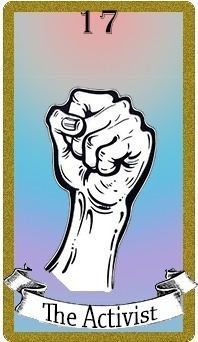 17 – The Activist
17 – The Activist
Without The Activist, nothing changes, nothing grows. The Activist is passionate, fearless, and self-sacrificing. Well aspected by surrounding cards, The Activist is a motivating force for change and progress. Poorly aspected, The Activist is critical and demoralizing, convinced that anyone with an opposing opinion is stupid and wrong and willing to pound that point home without hesitation.
At best, The Activist inspires and leads by example, encouraging us to find our voices and stand up for what we feel is right. At worst, The Activist is a bully who doesn’t know when to stop.
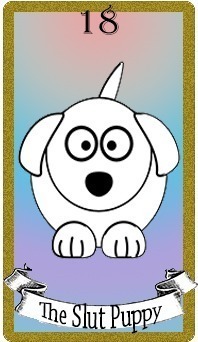 18 – The Slut Puppy
18 – The Slut Puppy
The Slut Puppy is VERY different from #1, The Creeper. Both are sexual as archetypes, but The Creeper’s advances are usually uncomfortable and unwelcome, where The Slut Puppy’s attentions are fun and expected. The Slut Puppy has likely had sex with many group acquaintances and will gladly have sex with more of them if allowed to do so. This archetype is not working from a “notch on the bedpost” objectifying perspective, but from a “Wheeee! Sex is funnnn!” approach.
When rejected, The Slut Puppy may become confused and subsequently, slightly pouty, but this person does not push the issue and consent is a policy they greatly understand and honor. Show them a green light, however, and it is game on.
Note: You know you are a Crone when The Slut Puppy uses parental terms of endearment like “Mom” or “Dad” for you and does not even try to make a pass. Go home and lick your wounds just like you did the first time you didn’t get carded when you bought alcohol for #11, The Drunk.
 19 – The Victim
19 – The Victim
This is not just “a” victim, but “The Victim” and we all know them. The perennial Victim always has a new woe, a new enemy who is after them, or a new joy that was squelched. The Victim defines themselves by their hardships and will usually compound this identity with a position of helplessness and hopelessness. Life is something that is done to them, not for them. They may attribute their maladies to bad karma or the ill-will or screw ups of others, but rarely will any accountability fall to The Victim themselves.
The Victim makes any ritual work a crusade for giving them more energy to change their situation. Unfortunately, since they are using group energy rather than making life changes to support the desired outcome, they become an endless pit of despair and longing, which may bring them dangerously close to #5, The Vampire. Count how many times you hear the tale of their current struggles. This may cause you to confuse them with #10, The Talker.
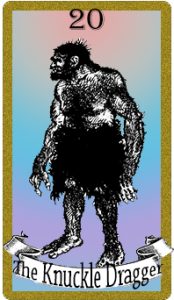 20 – The Knuckle Dragger
20 – The Knuckle Dragger
Since straight cis males are not the dominant force in Paganism, this archetype is the rarest of all of 22, but it still manages to manifest for nearly every group. The Knuckle Dragger is not always a straight cis male, but most Knuckle Draggers are straight cis males. In fact, they will so often remind you that that they are straight cis males that you begin to think that perhaps they doth protest too much.
The Knuckle Dragger is full on Pagan, but simultaneously endorses philosophies that are counter indicated for most Pagan groups, such as those that malign women, non-straight cis identifying people, and or encourage violent responses to opposition. Sometimes citing historical or ancestral entitlement to such behaviors, The Knuckle Dragger often over justifies their behavior with comments like, “What do you mean? Some of my best friends are gay!” or “I don’t really care if people don’t like how I think, that’s just how I am.”
Give The Knuckle Dragger heavy things to carry and make sure a strong female presence is up against them. By all means, do not situate The Knuckle Dragger next to #16, The Reluctant, or #14, The Goth Kid. They will do exceptionally well next to #11, The Drunk, or for fun, put them by #15, The Witch Police, #17, The Activist, or #8, The Witchsplainer.
 21 – The Reconstructionist
21 – The Reconstructionist
Make no mistake, Reconstructionists are great. Through them, we watch history come to life and reconstructionist spiritual paths (I’m looking at you, Druidism) are rife with energetic power flow. As a group, Reconstructionsts are fascinating and empowering.
Separately and as individuals, however, there are some wince-worthy moments. I am talking about the guy who suddenly begins speaking with a bad British accent as soon as they call in the quarters. Here is Dale, the guy who bags my groceries at Save Mart who I know from a fact was born and raised in Bakersfield, sounding like Dick Van Dyke in “Mary Poppins” when he’s summoning Air. He’s not at rituals to honor the turning of the Wheel, he’s at a Renn Faire he goes to every six weeks.
The Reconstructionist makes us look and feel foolish unless they truly are channeling down the Ghost of Stewart Farrar. In that case, “Carry, Dale. You’re way too legit to quit.”
 22 – The Angry Witch
22 – The Angry Witch
The Angry Witch is an interesting amalgam of #19, The Victim, and #9, The Drama Witch and yet is a level up for each of them. This archetype rarely has a genuine happy moment. They are angry about how their parents raised them, angry about how the long list of adversaries treated them, and angry that they are where they are. They are angry when anyone else gets ahead and they erupt in fury when the slightest thing goes wrong.
The Angry Witch loses the ability to revel in joy or release what no longer serves them. Their rage is their fuel and it infiltrates nearly every interaction. Often, the perceived slights are ego based with The Angry Witch feeling they do not receive the respect they deserve. My experience is that they are usually experiencing exactly the level of respect they deserve.
All Are People Too
It can be easy to think of these 22 personality types as negative assignments based on some of my comments. These are people, however, who are (usually) growing, learning, and becoming. It is up to us to decide how these archetypes fit into our Pagan experience, what works for us and what does not. Meanwhile, it has been fun to look at some of the people are multi-faceted community enfolds into itself. Eric and I once determined that Paganism’s greatest strength is its inclusivity and acceptance of everyone. We also simultaneously determined that Paganism’s greatest vulnerability is its inclusivity and acceptance of everyone.
Take care o’you, Boo.
